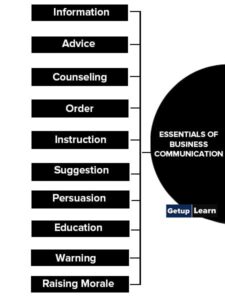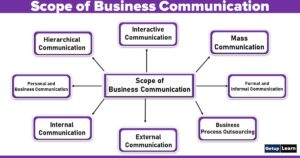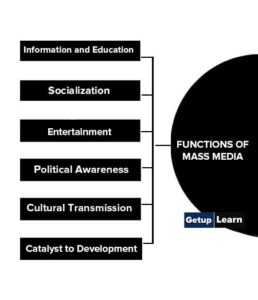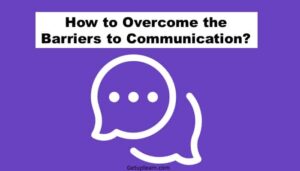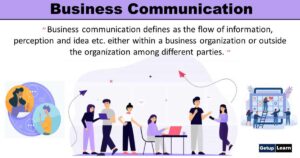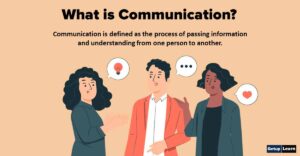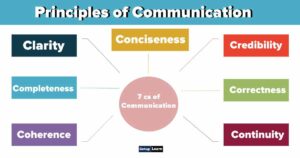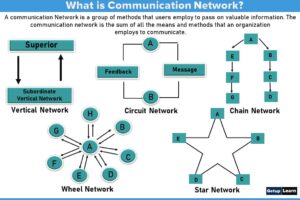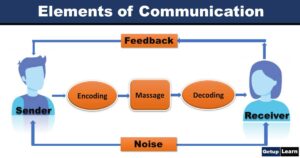Table of Contents
- 1 What is Human Communication?
- 2 Origins of Human Communication
- 3 Stages of Human Communication
-
4 Types of Human Communication
- 4.1 Intrapersonal Communication
- 4.2 Interpersonal Communication
- 4.3 Interpersonal Mediated Communication
- 4.4 Group Communication
- 4.5 Public Communication
- 4.6 Mass Communication
- 4.7 Transpersonal Communication
- 4.8 Metaphysical Communication
- 4.9 Extra-personal Communication
- 4.10 Nonverbal Communication
- 4.11 Verbal Communication
-
5 FAQ Related to Human Communication
- 5.1 What is human communication in simple words?
- 5.2 What are the 6 stages of human communication?
- 5.3 What are the various types of human communication?
- 5.4 What is interpersonal communication?
- 5.5 What is planetary communication?
- 5.6 What is vibrational communication?
- 5.7 What is body language in communication?
What is Human Communication?
Human communication is the exchange of information between two or more human beings, whether verbal (in speech and writing) or nonverbal. The study of this field involves contributions from psychology, social science, computer science, logic, and linguistics.
Human communication is the field dedicated to understanding how humans communicate. Human communication is grounded in cooperative and shared intentions. Humans have communication abilities that other animals do not.
Communicating aspects like time and place as though they were solid objects are a few examples. It is said that humans communicate to request help, inform others, and share attitudes as a way of bonding. Communication is a joint activity that largely depends on the ability to keep common attention, share the relevant background knowledge and collective experience to get the content across and make sense in the exchanges.
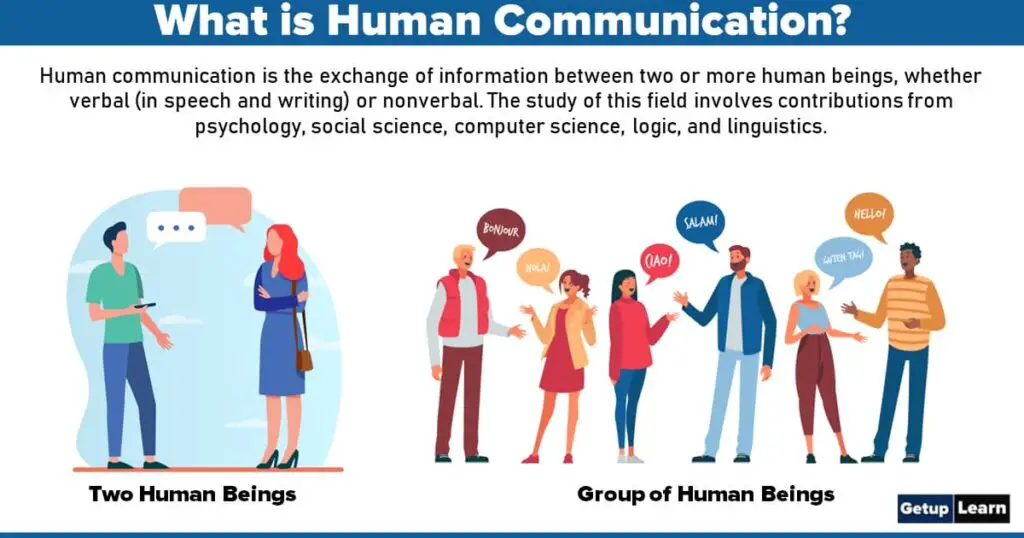
Human communication takes place between two or more human beings. It is a pervasive activity. It serves several important functions in society or our personal life. It is a constantly changing process. The moment a person stops the process, human communication no longer exists. Communication is a process that involves shared codes or codes of verbal or non-verbal symbols.
The meanings of symbols and gestures are in the people who use them, not in the symbols or gestures themselves. Human communication is not only source-oriented. It is receiver-oriented also. A source-oriented view focuses on the production of effective and efficient messages by the sender.
A receiver-oriented view focuses on the message’s meaning to the audience. Receiver-oriented definitions also include the concept of communication as any activity in which the receiver responds to a stimulus. Human communication was much different during the evolution of mankind than it is today.
There are drastic changes today, thanks to supersonic technological advancement. At present, human communication has really become a communication superhighway. What happens when something happens here now, reaches across the other part of the world in a fraction of seconds, converting the world into a global village.
It is because of these reasons and issues, it becomes relevant and important to discuss here the origin of human communication, growth of communication, various stages of growth of human communication, effects of human communication on culture, society, and civilization, and various types of human communication.
Origins of Human Communication
Human communication was born when man was born. A child communicates even before his or her birth. This truth, however, relates to only body language. A child mostly communicates with the help of a cry. Sometimes with a smile. And more often with many other gestures which many people cannot understand except his close associates like mother, father, grandmother, etc.
But there are many other types of human communication even nonverbal communication which sprouted, budded, and bloomed bit by bit. It was during the pre-historic era that the fossil records gathered and recovered by paleo- anthropologists indicate that the debut-making development in the origin and evolution of human beings was held almost 70 million years back.
Our first and foremost ancestors were found to be rat-like creatures that did exist during the time of dinosaurs. A few more million years later, one cat-like animal grew up. Approximately 5 million years back, an ape-like creature also evolved. It lived in Africa, walked upright, dwelled, and survived in caves and rock shelters in a group.
These creatures widely and largely grew and spread from Africa to Europe and the Rest of the world gradually. Around two million years ago, yet another creature originated and grew up and was appearing to be much more developed. These creatures which were bigger in size and dimension were the first ones to make tools, mastered fires, and lived in much bigger groups.
It was in this way the process of human civilization started. These creatures were looking like monkeys and chimpanzees. Later they grew into the human species. On the basis of evidence and proof from fossil data, information, and records, experts from the field of anthropology prepared a chronology of the growth and development of human communication.
But they could not utter or construct a single word. The confused noises and cumbersome signals created a situation that made communication a complex process. However, smoke and fires were also used frequently as modes of communication by people of that age.
Stages of Human Communication
Human communication went on changing from time to time, from place to place, from community to community, and from culture to culture. These are the stages of human communication:
- Age of Signs and Symbols
- Age of Speech and Language
- Age of Writing
- Age of Print
- Age of Mass Communication
- Age of Information Revolution
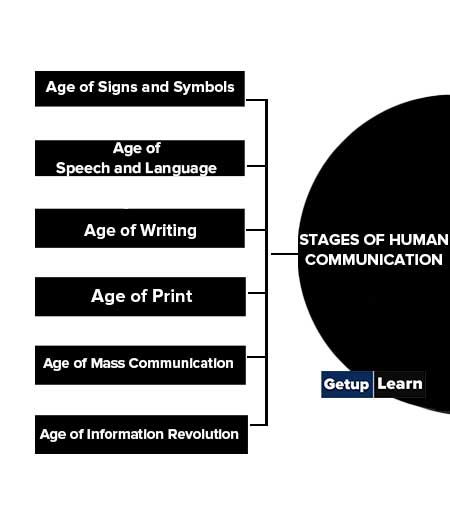
Age of Signs and Symbols
During this age, human beings used noises and body movements consisting of mutually understood signs and signals devised by the groups living together. Their noises and body movements constituted growls, grunts, and shrinks.
One of the most remarkable achievements in the origin and growth of human communication is described to be communication with the help of signs and symbols. But during this age, they could not speak, due to their underdeveloped voice-box. They could make noises.
Age of Speech and Language
During this period, the Cro-Magnon men used their fullest efficiency and ability to communicate and grew towards human civilization. Human beings of their age moved from place to place and during the process. They learned new languages which they started spreading largely and widely.
They developed a variety of words, numbers, ulfa-numerics, and the basic syntax and grammar of the language. This gradually made the use of language much easier. In due course of time, their language also became effective, efficient, and standardized.
What is more significant is that language development helped in a big way to the growth and development of new culture, civilization, and society as a whole. Language may not be described to be the only reason for these changes. Yet such changes would not have taken place without language.
Age of Writing
After the growth and development of speech and language, it only took a few hundred years for writing to sprout, bud and bloom. The origin of growth and development of writing constitutes developments from pictorial or pictographic representations to phonetic systems. While pictures are representative of objects and scenes, pictography represents ideas with pictures and drawings.
On the other hand, the phonetic system uses simple letters and symbols to imply specific and meaningful sources. After phonetic writing, there was growth and development of alphabetical writing. This took place 1000 years after the establishment of phonetic writing.
Human beings of that period were gratified even with the hundred-odd symbols. These symbols were later reduced to about two dozen. With the simplification of these symbols, there were growth and development of simpler combinations of straight and curved lines.
The most simplified and standardized form of alphabetical writing was developed by the Greeks in 500 BC. The Greeks added five vowels and 26 consonants to the alphabet and later passed these alphabets to Rome. Then the Romans studied, explored, modified, and improved these alphabets even better and simpler.
It was also complex, cumbersome, tedium, and prone to mistakes. Moreover, the quality and quantity of manual processes were also very low. They gradually developed capital and small letters also described as “Upper Case” and “Lower Case” respectively in journalistic parlance. Our culture, civilization, and society made really big strides just because of the fact that human beings of this age started reading and writing.
Age of Print
Soon after the growth and development of writing, human beings started developing a knack for printing. Preparing printing plates by way of carving wooden blocks, metal plates, and stone tablets was the earliest breakthrough by man. In the beginning, all such activities as engraving, inking, and transforming the images on paper were executed manually.
But this manual practice was time-consuming, money-consuming, energy-consuming, and resource-consuming. By the end of the 15th century, many countries across the globe developed new technologies and devices for producing paper and ink along with a technique of manual printing. The greatest change in this field was brought about by a noted German printing technologist John Gutenberg.
Heis called the father of printing. He has the credit for two very relevant, useful, and important developments, i.e., movable types of the mechanical printing press. Yet another innovation and modification in this era was the process of inking and eventually developing a mechanism for bringing two surfaces together in order to transfer the images.
Again after the growth of literacy and education in this age, thousands of books, journals, and periodicals were brought out in reasonably good numbers. These publications covered almost all the relevant areas like society, politics, economy, religion, spiritualism, education, and culture. It finally led to the printing of newspapers and magazines. By the end of the 18thcentury, newspapers were widely and largely available and emerged as a powerful vehicle of communication.
Age of Mass Communication
The growth and development of printing gave impetus to the enhancement of mass media including newspapers, magazines, journals, periodicals, etc. In the 19th century, print media was also supplemented with the telephone and telegraph.
The telephone and telegraph are not a means of mass communication, yet they added tremendously to the growth of radio, television, and other broadcasting technologies. The introduction of film in the 20th century in the type of motion pictures brought miracles. In the 1920s, radio broadcasting started and gave birth to television in the 1940s. Thus the 20th century saw the emergence of the age of mass communication.
Age of Information Revolution
The present age is the age of the information revolution. In this era, integrated multi-media applications are easily possible. This is mainly because of networks set up from the growth and development of digital technology. Satellite technology is frequently used for weather forecasting and even for mobile communication.
Hence, the birth of satellite radio and satellite television led to the production of high-quality programs. Moreover, hypertext formats and structures have recently emerged as the cornerstone for navigation and communication in the system.
Types of Human Communication
These are the types of human communication:
- Intrapersonal Communication
- Interpersonal Communication
- Interpersonal Mediated Communication
- Group Communication
- Public Communication
- Mass Communication
- Transpersonal Communication
- Metaphysical Communication
- Extra-personal Communication
- Nonverbal Communication
- Nonverbal Communication
- Verbal Communication
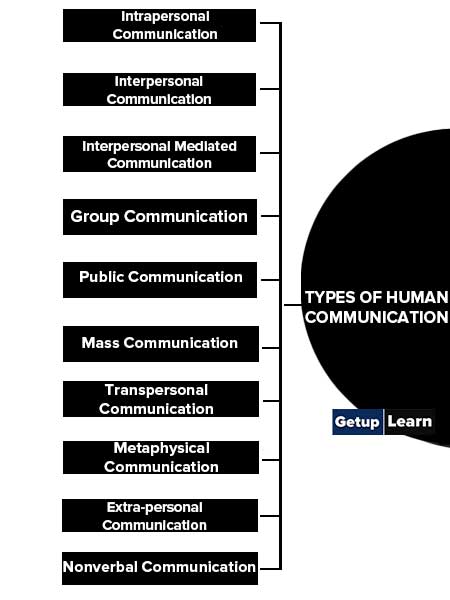
Types of human communication can be categorized into two on basis of:
- Functional
- Structural
Following are the types of human communication on basis of functionality:
- Intrapersonal Communication
- Interpersonal Communication
- Interpersonal Mediated Communication
- Group Communication
- Public Communication
- Mass Communication
- Transpersonal Communication
- Metaphysical Communication
- Extra-personal Communication
- Nonverbal Communication
Intrapersonal Communication
Intrapersonal communication is communication within the self. For example, self-talking, thinking, dreaming, meditating, penancing, etc. In this type of communication, there is only one person. The same person is the source and the same person is the receiver. The same person is the encoder and the same person is the decoder. There is always a self-feedback.
The same message comes from the source and the same message is received by the same source-receiver. It is a communication between the unconscious, subconscious and conscious parts of the self. In a more common language, it is also described as communication between the mind, body, and soul of the self.
In this type of communication, there is minimum noise and it is the most intimate type of communication. This is because self-language is to be received by the self; self-culture is to be retained by the self, self-psychology is to be understood by the self, and so on and so forth. Thus the stimulus and response inter-change and ultimately coincides at the same point.
Interpersonal Communication
In this type of human communication, there will be only two persons: one sender and one receiver. This communication is also described as very intimate communication as the frequency of feedback is extremely high. It is also called face-to-face communication.
It is less intimate than intrapersonal communication but more intimate than group communication. Here in this type of communication, there is a single encoder and a single decoder. Hence, the stimulus and the response frequently activate, vibrate and react with two points only.
Interpersonal Mediated Communication
Interpersonal mediated communication is again a glorified and modified type of interpersonal communication that exists between two persons. But a media or device or tool or instrument will come between two persons. It is not face-to-face communication. But it may be created as face-to-face communication artificially and in a virtual situation.
For example, telephone-talking or chatting between two persons either through mobile, tab, laptop or PC. Even writing a letter to a single individual is an interpersonal mediated communication. In modern times, there is a facility for face-to-face video chatting.
But that face-to-face is not considered to be real, but virtual. Since there are only two persons in such communication, so it is also a very intimate type of communication. It is more intimate than group communication but less intimate than interpersonal or face-to-face communication in the real world.
This is because a media technology between the two communicators always creates some channel or technical or semantic noise.
Group Communication
In group communication, there should be more than two people. For example, a family, a classroom, or a meeting. It can be like a group of family members, a group of students, or a group of teachers. The audience of a group is relatively homogenous and the size of the audience is generally less than a public or a mass.
Again, group communication is more intimate than a public or a mass because of its smaller size, homogenous nature, and frequent feedback and interaction. Hence, a classroom is often divided into further small groups for tutorial classes in order to establish a more intimate and effective type of communication. Here again, the audience is more or less heterogeneous, diversified, and anonymous.
Public Communication
A public is a combination of several categories, and groups and is generally much larger than a group and more heterogeneous than a group. In group communication, each and every member is often known to each other while in public this is not the case. Public communication is less intimate and less effective and there is hardly any scope for feedback.
Mass Communication
In Mass Communication, there is a large audience, which is heterogeneous in nature. The audience of a mass is not sitting at a place, rather it is scattered in distant places. It is a combination of several small groups and big groups sitting distantly and in a scattered manner.
There is no scope for any immediate feedback. In mass communication, since the audience is large, heterogeneous, anonymous, and scattered distantly in a large geographical area, a technology or devise is used to communicate. This technology or device is called mass media. For example, magazines, newspapers, radio, television, film, etc.
Transpersonal Communication
Transpersonal communication is not man-to-man communication. One unit will be a man while the other unit will not be a man. The other unit may be a bird, animal, God, tree, plant, river, mountain, etc. when a man worships or communicates to his pet dog or cat or horse or cow, or parrot, it is transpersonal communication.
When a human being communicates to God or nature or planets or vibrations, it is also transpersonal communication.
Metaphysical Communication
Metaphysical Communication is also called spiritual communication. This relates to self-knowledge. This pertains to self-exploration. This is also described as godly communication. That means at least one unit may be God within or outside. In Metaphysical Communication, there is communication between man to God and God-to-man. God-to-God, man-to-nature, nature-to-man, planet-to-planet, vibes-to-vibes, etc.
The communication between planet to planet is called planetary communication which is an integral part of metaphysical communication or spiritual communication. The communication between vibes to vibes is called vibrational communication which is again an integral part of metaphysical communication or spiritual communication.
Vibrational communication believes that every thought, word, and deed has certain vibrations which affect us either positively or negatively and creates a relaxed atmosphere.
Extra-personal Communication
Extra-personal Communication is communication between two or more machines. For example, teleprinter to teleprinter communication or any other type of networking between two or more devices. Here human beings are not involved directly, except for some nominal indirect role. As far as structural communication is concerned, it is non-verbal as well as verbal as discussed earlier also. Now let us discuss this one by one.
Following are the types of human communication on basis of structure:
Nonverbal Communication
That communication in which words are not used. Only signs, symbols, and body movements like posture, gesture, pitch, tone, modulation, etc. are used here. Thus, nonverbal communication may be divided into two types:
Body Language
In body language, body movements, hand movements, eye movements, eye contacts, postures, gestures, pitches, tones, modulations, vibrations, etc. are used. This science of body language is often described as ‘KINESICS’. Deaf and dumb news on television is the best example of body language or kinesics.
Symbolic Communication
As far as symbolic communication is concerned, it uses only signs and symbols. For example, red light, green light, yellow light, arrow, cross, dotted lines on roads, etc. in the traffic are examples of signs and symbols. Even mathematical connotations are other glaring examples of symbolic communication.
Verbal Communication
In this type of communication, words are used. Hence, oral communication and written communication are both verbal communication. Nonverbal communication can go without verbal communication, but not vice versa. That means verbal communication cannot take place without non-verbal communication.
When we speak, we are bound to move our leaps, tongue, etc. Even when we write, we are bound to move our hands and fingers.
Read More Related Articles
[su_spoiler title=”What is Communication? | Mass Communication” style=”fancy” icon=”plus-circle”]
What is Communication?
[/su_spoiler]
[su_spoiler title=”Types of Communication | Principles of Communication” style=”fancy” icon=”plus-circle”]
-
Types of Communication
- Verbal Communication
- Non-Verbal Communication
- Written Communication
- Visual Communication
- Feedback Communication
- Mass Communication
- Group Communication
[/su_spoiler]
[su_spoiler title=”Nonverbal Communication | Verbal Communication” style=”fancy” icon=”plus-circle”]
Nonverbal Communication
[/su_spoiler]
[su_spoiler title=”Written Communication | Oral Communication” style=”fancy” icon=”plus-circle”]
Written Communication
[/su_spoiler]
[su_spoiler title=”Business Communication | Organizational Communication” style=”fancy” icon=”plus-circle”]
[/su_spoiler]
[su_spoiler title=”Formal Communication | Informal Communication” style=”fancy” icon=”plus-circle”]
[/su_spoiler]
[su_spoiler title=”Interpersonal Communication | Informal Communication” style=”fancy” icon=”plus-circle”]
Interpersonal Communication
[/su_spoiler]
[su_spoiler title=”Downward Communication | Upward Communication” style=”fancy” icon=”plus-circle”]
[/su_spoiler]
[su_spoiler title=”Barriers to Communication | Horizontal or Lateral Communication” style=”fancy” icon=”plus-circle”]
[/su_spoiler]
[su_spoiler title=”Self Development | Effective Communication” style=”fancy” icon=”plus-circle”]
[/su_spoiler]
[su_spoiler title=”Difference Between Oral and Written Communication | Theories of Communication” style=”fancy” icon=”plus-circle”]
[/su_spoiler]
What is human communication in simple words?
Human communication is the exchange of information between two or more human beings, whether verbal (in speech and writing) or nonverbal. The study of this field involves contributions from psychology, social science, computer science, logic, and linguistics.
What are the 6 stages of human communication?
Following are the stages of human communication:
1. Age of Signs and Symbols
2. Age of Speech and Language
3. Age of Writing
4. Age of Print
5. Age of Mass Communication
6. Age of Information Revolution.
What are the various types of human communication?
Types of Human Communication:
1. Intrapersonal Communication
2. Interpersonal Communication
3. Interpersonal Mediated Communication
4. Group Communication
5. Public Communication
6. Mass Communication
7. Transpersonal Communication
8. Metaphysical Communication
9. Extra-personal Communication
10. Nonverbal Communication.
What is interpersonal communication?
Interpersonal Communication: Exchange of information between individuals, using not only language, but also other modes, such as gesture, body posture, and so on.
What is planetary communication?
Planetary Communication: The communication between planet to planet is called planetary communication.
What is vibrational communication?
Vibrational Communication: The communication between vibes to vibes is called vibrational communication which is an integral part of metaphysical communication or spiritual communication.
What is body language in communication?
Body Language in Communication: In body language, body movements, hand movements, eye movements, eye contacts, postures, pitches, gestures, tones, modulations, vibrations, etc. are used.

